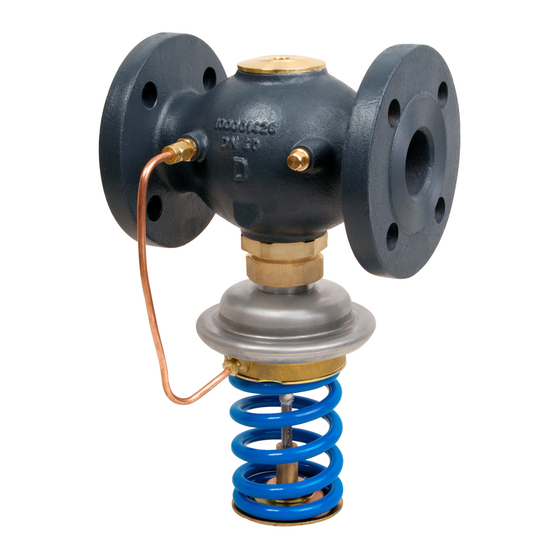Danfoss SAVA DN 50 Anleitung Handbuch - Seite 5
Blättern Sie online oder laden Sie pdf Anleitung Handbuch für Controller Danfoss SAVA DN 50 herunter. Danfoss SAVA DN 50 16 Seiten. Safety pressure relief controller

ENglISh
Safety Notes
Prior to assembly and commissioning
to avoid injury of persons and damages
of the devices, it is absolutely necessary
to carefully read and observe these
instructions.
Necessary assembly, start-up, and
maintenance work must be performed
only by qualified, trained and authorized
personnel.
Prior to assembly and maintenance work
on the controller, the system must be:
- depressurized,
- cooled down,
- emptied and
- cleaned.
Please comply with the instructions of the
system manufacturer or system operator.
Definition of Application
The controller is used for pressure relief
control and as a protection against excess
pressure in front of the valve. The controller
is used for water and water glycol mixtures
for heating, district heating and cooling
systems.
Controller is design-tested according to
DIN 4747 (SÜV) and the AGFW guidelines.
The technical parameters on the product
labels determine the use.
Disposal instruction
This product should be
dismantled and its
components sorted, if
possible, in various groups
before recycling or disposal.
Always follow the local disposal
regulations.
Assembly
Admissible Installation Positions ❶
Medium temperatures up to 100 °C:
- Can be installed in any position ①.
Medium temperatures > 100 °C:
- Installation permitted only in
horizontal pipelines with the actuator
oriented downwards ②.
Installation location and
Installation Scheme ❷
SAVA mounting
Secure the shut-off unit ① against
unauthorized opening.
73695100 DH-SMT/SI
Valve Installation ➌
1. Clean pipeline system prior to assembly.
2. Install a strainer in front of the
controller ①.
Max. mesh width
DN 15 - 25: 0.5 mm
DN 32 - 50: 0.8 mm
3. Install pressure indicators in front of and
behind the system part to be controlled.
4. Install valve
• The flow direction indicated on the
product label ② or on the valve ③
must be observed.
• The valve with mounted weld-on
tailpieces may only be spot welded to
the pipeline ④.
The weld-on tailpieces may be welded
only without the valve and seals! ⑤⑥
If these instructions are not observed,
high welding temperatures may
destroy the seals.
• Flanges ⑦ in the pipeline must be in
parallel position and sealing surfaces
must be clean and without any
damage.
Tighten screws in flanges crosswise
in 3 steps up to the maximum torque
(50 Nm).
5. Caution:
Mechanical loads of the valve body by the
pipelines are not permitted ⑧.
Insulation ➍
Do not insulate the pressure actuator ①.
Dimensions, Weights ❺
(See page 2)
1)
Conical ext. thread acc. to EN 10226-1
2)
Flanges PN 25, acc. to EN 1092-2
Start-up
❻
The valve is closed without pressure. The
valve opens when the pressure in front
of the valve ① rises above the adjusted
set-point.
Filling the system, first start-up
To avoid too high pressure differences
on the controller, observe the following
sequence when opening the shut-off
valves:
1. Release spring ⑤ by turning the set-
point adjuster ④.
2. Slowly open shut-off devices in the
return pipeline ②.
3. Slowly open shut-off devices in the
supply pipeline ③.
leak and Pressure Tests
To avoid inadmissible pressures on the
actuator (admissible excess pressure
during operation is 14 bar) it is absolutely
necessary to remove the impulse tube
VI.DC.F2.8M
© Danfoss04/2011
⑥. Close connections with plugs G 1/8 ISO
228 ⑦. In this case valve is always closed.
Pressure must be gradually increased at
the +/- connection.
Non-compliance may cause damages at
the actuator or the valve.
A pressure test of the entire system
must be carried out in accordance with
manufacturer's instructions.
The maximum test pressure is: 1.5 × PN
PN - see product label!
Putting out of operation
1. Slowly close shut-off devices ③ in the
flow pipeline.
2. Slowly close shut-off devices ② in the
return pipeline.
Settings ❼
Pressure Setting
The pressure setting range is indicated on
the product label ①.
Procedure:
1. Start system, see section "Filling the
system, first start-up"
Completely open all shut-off devices in
the system.
2. Adjustment
(of the pressure in front of the valve)
Observe pressure indicators ②.
• Turning to the right ③ (clockwise)
increases the set-point (stressing the
spring).
• Turning to the left ④ (counter-
clockwise) reduces the set-point
(releasing the spring).
Seal ❽
The set-point adjuster can be sealed by a
seal wire ①, if necessary.
Safety function ❾
If the control diaphragm ① beaks, pressure
gets in the two intermediate chambers ②.
This pressure acts upon the safety
diaphragm ③ and causes the following:
- The valve opens
- The control function does not operate
- A slight water leakage at the threaded
joint ④ of the upper casing indicates a
break of the diaphragm
The controller must be replaced when the
diaphragm is broken.
5
